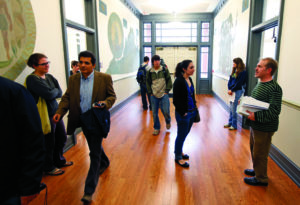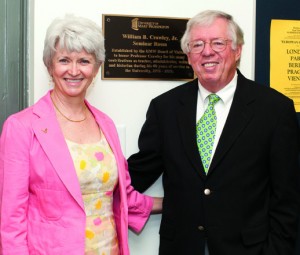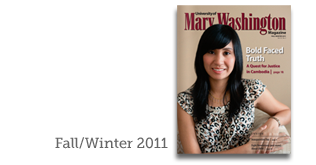
Monroe Hall, the first academic building on campus, reopened for the fall semester after extensive renovation. Photo by Norm Shafer
After two years of renovations, Monroe Hall reopened with the fall 2011 semester and was rededicated with celebration and ceremony Sept. 16.
The rededication came almost 100 years after Monroe, Mary Washington’s first academic building, opened its doors to students, said William B. Crawley Jr., distinguished professor emeritus of history and American studies.
“Commemorating the reopening of Monroe could hardly come at a more appropriate time historically,” said Crawley, who is also the University Historian. He has had an office in Monroe Hall for more than 40 years, and this is the second time he’s seen the building renovated.
That sunny September afternoon, a crowd gathered in front of the building’s familiar columns and façade for an outdoor ceremony. The Board of Visitors was on hand for the official ribbon cutting. President Richard V. Hurley, Rector of the Board Dan Steen ’84, and Provost Jay Harper spoke, as did Crawley and Jeffrey W. McClurken ’94, associate professor and chair of the Department of History and American Studies.
McClurken, who spent many of his undergraduate days in Monroe, thanked those who had made the renovation happen. Some things in the building remain unchanged, such as paintings done in the 1940s by students and Professor of Art Emil Schnellock, even as advances show up all around.
“The murals in the main hallway surround students working on laptops or smartphones or iPads,” McClurken said.
The renovated building is wired for technology. Monroe Hall has a digital media lab, a GIS and cartography lab, and a pollen-analysis lab that will help students reconstruct past environments to study climate change. There are more student spaces, he said, and they are wired and furnished for comfortable hi-tech collaboration. The first-floor auditorium has been updated and a light-filled 80-person lecture hall has been added on the third floor.
Monroe Hall architects added a fourth floor where the Department of Sociology and Anthropology is based. It has skylights, new offices, and a new library. Other departments in the building include history and American studies, political science and international affairs, and geography.
The day before the rededication, McClurken had spoken for the Department of History and American Studies at another celebration. He accepted the gift of the William B. Crawley Jr. Endowment for Student Research and the associated seminar room of the same name.
McClurken thanked Crawley for his service and generosity, and he also thanked Theresa “Terrie” Young Crawley ’77, Crawley’s wife, for her many gifts to UMW and for establishing the endowment to honor her husband’s retirement from the faculty and his long and rich service to Mary Washington.
Longtime colleagues, many of whom are retired; former and current students; and friends of the Crawleys gathered inside Monroe Hall Sept. 15 to dedicate the seminar room.

Theresa “Terrie” Young Crawley ’77 honored husband William B. Crawley Jr. by establishing a UMW research endowment in his honor. A Monroe Hall seminar room is also named for Professor Crawley.
During his career, Crawley created many student seminars that were forerunners to those now offered to every UMW freshman, said McClurken, who has fond memories of Crawley’s class History of the American South.
“Small classes taught in small classrooms match well Bill’s teaching style, in which one is put at ease personally while at the same time thoughtful engagement, careful analysis, and academic rigor are expected,” McClurken said. “It is, in other words, truly fitting for this room in this historic building to be named in his honor.”
For his part, Crawley had praise and thanks to the University and all it gave him over the years – the opportunity to develop the Historic Preservation Program and the Great Lives Lecture Series; “wonderful” colleagues, special among them his dear friend Otho Campbell, associate professor emeritus of history, who was at the ceremony; and family beyond measure.
“In terms of the debt I owe to Mary Washington,” Crawley said, “the most important by far is that it enabled me to meet Terrie.”
